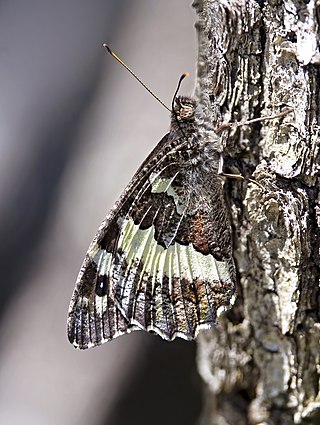
The brown hairstreak is a butterfly in the family Lycaenidae. The range includes most of the Palaearctic.

Apatura iris, the purple emperor, is a Palearctic butterfly of the family Nymphalidae.

The Niobe fritillary is a species of butterfly in the family Nymphalidae.

Apatura ilia, the lesser purple emperor, is a species of butterfly native to most of Europe and east across the Palearctic. It is named for its similarity to the purple emperor butterfly.

The scarce copper is a butterfly of the family Lycaenidae.

Parnassius stubbendorfi is a high-altitude butterfly found in from the Altai Mountains across central, south, and far east Siberia, Sakhalin and the Kuril Islands and from Mongolia across north China to west Korea and Japan (Hokkaido). It is a member of the snow Apollo genus (Parnassius) of the swallowtail family (Papilionidae).

Erebia epistygne, the spring ringlet, is a species of butterfly in the family Nymphalidae. It is found in France and Spain. Its natural habitat is temperate grassland.

The yellow-spotted ringlet is a member of the subfamily Satyrinae of the family Nymphalidae. It is associated with (sub)alpine meadows at 900–2,500 m above sea level. It is found in the Alps, the Pyrenees, the Cantabrian Mountains, the Massif Central, the Vosges Mountains, the Carpathian Mountains and the mountains of Herzegovina.
Parnassius przewalskii is a high-altitude butterfly which is found in Tibet and west China. It is a member of the snow Apollo genus (Parnassius) of the swallowtail family (Papilionidae).

Melitaea aurelia, or Nickerl's fritillary, is a butterfly of the family Nymphalidae. It is found in central Europe.

Chazara briseis, the hermit, is a butterfly species belonging to the family Nymphalidae. It can be found in North Africa, southern Europe, Asia Minor, the Caucasus, Kazakhstan, Central Asia through Afghanistan, and north-western China and Tuva. It is found on steppe and in other dry grassy places between 500 and 2,500 meters.

Brintesia is a monotypic butterfly genus in the family Nymphalidae and subfamily Satyrinae. Its one species is Brintesia circe, the great banded grayling.

Melitaea arduinna, or Freyer's fritillary, is a butterfly of the family Nymphalidae. It is found from south-eastern Europe across Asia Minor to central Asia and the Altai. The habitat consists of steppe-clad slopes.

Celastrina oreas is a small butterfly found in the East Palearctic that belongs to the lycaenids or blues family.

Issoria eugenia is a small butterfly found in the East Palearctic that belongs to the family Nymphalidae.

Mimathyma schrenckii is a butterfly found in the East Palearctic that belongs to the Nymphalidae family.

Mimathyma nycteis is a butterfly found in the East Palearctic that belongs to the browns family.

Dilipa fenestra is a butterfly found in the East Palearctic that belongs to the browns family.

Satyrium eximius is a butterfly found in the East Palearctic that belongs to the blues family.

Apatura laverna is a butterfly found in the Palearctic that belongs to the emperors group within the brushfooted family. It is endemic to China.





















